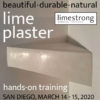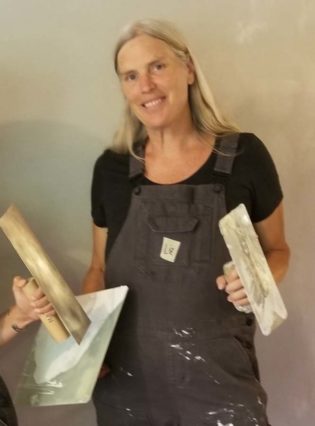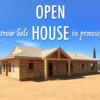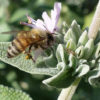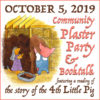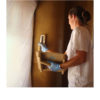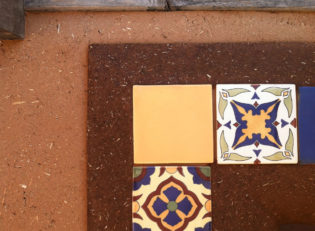
When I consider what plaster to use, I always think of clay plaster first. I love clay plaster, it has so much going for it.
In terms of minimizing environmental impact and carbon footprint, you cannot beat clay plaster. It is minimally processed, needs no additives, and can be sourced locally.
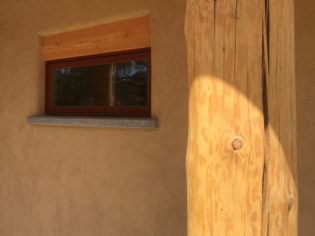
Building well with straw bales (and straw-clay, adobe, cob, and other natural building systems) requires an understanding of moisture: vapor permeability, diffusion, wicking, etc. This leads to needing to understand plasters.
Clay plaster is one of the most vapor-permeable finishes, coming in at 11 perms per 2″ of plaster. This makes it ideal for any building system where you do not want trapped moisture — which should be the goal for every building system but is often ignored in conventional construction.
Clay plaster has many benefits, but it does have some limitations. Once it gets wet enough, it will erode. It is also not as hard or impact-resistant as some finishes. Sometimes you need a plaster that can fulfill different duties. This is when I turn to lime plaster.
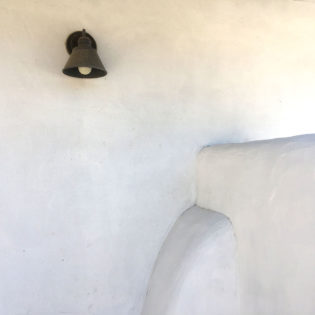
Lime plaster has a slightly lower carbon footprint than cement plaster and is more vapor-permeable than cement (lime plaster is 9 perms per 2″ where straight cement plaster is less than 1 perm per 2″).
If you do it right, lime plaster goes through a chemical change as it cures that effectively turns it back into limestone on the wall. It will not erode. It is harder and more impact-resistant than clay.
Lime plaster used to be very common in the US but was replaced by drywall and gypsum-based plasters in the last century. Then it became difficult to source lime of high enough quality to produce consistently good lime plaster. Although it is possible to make a good lime plaster from locally-available Type S lime, it requires knowledge, skill, and a fair bit of babying to succeed.
On larger-scale projects, like the exterior of a strawbale home in a climate that gets sideways monsoon rains, we will make our own Type S lime plaster, don our gloves and safety glass, apply the plaster skillfully before it begins to set, and then tend to it patiently until it has cured.
Hydraulic lime is another option. It still requires knowledge and skill, but it sets faster and more consistently with less babying. You could import hydraulic lime from Europe, where the tradition of lime plaster had not been broken, but at a high cost financially and environmentally.
So you can see why I gravitate towards clay plaster whenever possible. I encourage clients to build wrap-around-porches to take advantage of outdoor living and to allow for clay-plastered exterior walls.
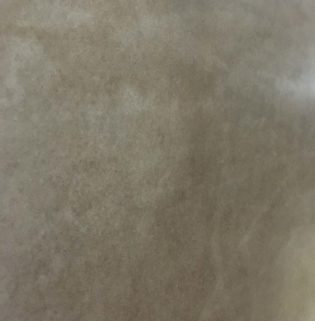
On a smaller scale, like a bathroom, lime plasters are a little less daunting. When applied well and polished, lime plaster can look and feel like marble. When finished in the tadelakt tradition, by rubbing oil-based soap into the plaster before it has cured, it can be remarkably waterproof. But these thin veneer plasters leave little room for error or inconsistency, so I have been reluctant to sell them to clients.
I recently became aware of a product called Limestrong. It is a bagged lime plaster created by the talented plasterer Ryan Chivers, in partnership with other experts in plaster chemistry. In my mind, it is the lime equivalent of American Clay Plaster: a convenient, bagged, premeasured plaster with a tested range of pigments that allow you to create a consistent result time after time. And, like American Clay, you do pay more for this convenience.
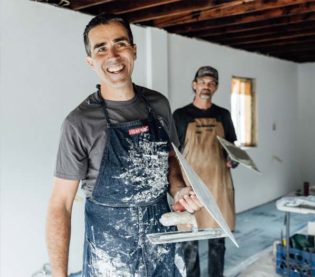
At the 2020 Natural Plasterers’ Guild Retreat in January in Jacksonville, Oregon, I had a chance to learn more about Limestrong and see Ryan demonstrate the line of products.
Most importantly to me, Limestrong sources all of its ingredients from the US. Since lime itself has a larger carbon footprint due to the amount of heat needed to process it, keeping the embodied carbon involved in shipping as low as possible is important.
Limestrong uses pumice as the aggregate. This not only makes it lighter to ship (and carry around the job site), the pumice creates a mild pozzolanic effect, making the plaster slightly hydraulic. Although this means a faster set time, it also ensures a more even cure.
The only additive in Limestrong is cellulose, which is a non-toxic material that helps retard the set and acts as an adhesive to help it stick to difficult substrates like painted drywall.
So it is with great excitement that we have decided to host a professional plasterers’ training for Limestrong plasters at our current job site in Valley Center, CA, in March. We will learn directly from Ryan Chivers and his co-teacher Liz Johndrow about applying Limestrong over drywall. If time and interest permit, we may also install Limestrong over a clay plaster base coat on a straw bale wall. Attendees will also be able to observe two tadelakt shower surrounds being installed by our crew. Exciting stuff!
If you are an experienced plasterer who is interested in attending this training, join us to learn about this great product. Here is a link to the registration.

